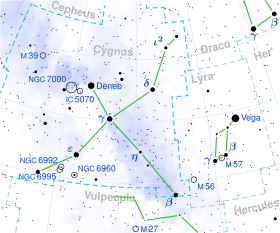| Observation data Epoch J2000.0 Equinox J2000.0 (ICRS) | |
|---|---|
| Constellation | Cygnus |
| Right ascension | 19h 56m 18.37222s[1] |
| Declination | +35° 05′ 00.3228″[1] |
| Apparent magnitude (V) | 3.889[2] |
| Characteristics | |
| Spectral type | K0 III[3] |
| U−B color index | +0.881[2] |
| B−V color index | +1.035[2] |
| Astrometry | |
| Radial velocity (Rv) | −25.87±0.14[4] km/s |
| Proper motion (μ) | RA: −33.61[1] mas/yr Dec.: −27.87[1] mas/yr |
| Parallax (π) | 24.17 ± 0.15 mas[1] |
| Distance | 134.9 ± 0.8 ly (41.4 ± 0.3 pc) |
| Absolute magnitude (MV) | 0.74[5] |
| Details[4] | |
| Mass | 1.59[6] M☉ |
| Radius | 11 R☉ |
| Luminosity | 52.5 L☉ |
| Surface gravity (log g) | 2.7 cgs |
| Temperature | 4,783±20[6] K |
| Metallicity [Fe/H] | −0.09 dex |
| Rotational velocity (v sin i) | 2.2 km/s |
| Age | 3.29[6] Gyr |
| Other designations | |
| Database references | |
| SIMBAD | data |
Eta Cygni (η Cygni) is a star in the northern constellation of Cygnus. It is visible to the naked eye with an apparent visual magnitude of 3.889.[2] The star lies along the main body of the constellation, about midway between Gamma Cygni and Albireo.[8] Based upon an annual parallax shift of 24.17 mas,[1] it is located 135 light years from the Sun.
At an age of about 3.3[6] billion years, this is an evolved red clump[9] giant star with a stellar classification of K0 III.[3] It is presently on the horizontal branch and is generating energy through the nuclear fusion of helium at its core. The star has about 1.59[6] times the mass of the Sun and has expanded to 11[4] It radiates 52.5 times the solar luminosity from its outer atmosphere at an effective temperature of 4,783 K.[6]
Eta Cygni has five visual companions,[10] of which only component B appears to be physically associated. This magnitude 12.0 star lies at an angular separation of 7.80 arc seconds along a position angle of 206°, as of 2007.[11]
References
- ^ a b c d e f van Leeuwen, F. (2007), "Validation of the new Hipparcos reduction", Astronomy and Astrophysics, 474 (2): 653–664, arXiv:0708.1752, Bibcode:2007A&A...474..653V, doi:10.1051/0004-6361:20078357, S2CID 18759600.
- ^ a b c d Oja, T. (August 1986), "UBV photometry of stars whose positions are accurately known. III", Astronomy and Astrophysics Supplement Series, 65 (2): 405–409, Bibcode:1986A&AS...65..405O.
- ^ a b Morgan, W. W.; Keenan, P. C. (1973), "Spectral Classification", Annual Review of Astronomy and Astrophysics, 11: 29–50, Bibcode:1973ARA&A..11...29M, doi:10.1146/annurev.aa.11.090173.000333.
- ^ a b c Massarotti, Alessandro; et al. (January 2008), "Rotational and Radial Velocities for a Sample of 761 HIPPARCOS Giants and the Role of Binarity", The Astronomical Journal, 135 (1): 209–231, Bibcode:2008AJ....135..209M, doi:10.1088/0004-6256/135/1/209, S2CID 121883397.
- ^ Cardini, D. (January 2005), "Mg II chromospheric radiative loss rates in cool active and quiet stars", Astronomy and Astrophysics, 430: 303–311, arXiv:astro-ph/0409683, Bibcode:2005A&A...430..303C, doi:10.1051/0004-6361:20041440, S2CID 12136256.
- ^ a b c d e f Luck, R. Earle (September 2015), "Abundances in the Local Region. I. G and K Giants", The Astronomical Journal, 150 (3): 23, arXiv:1507.01466, Bibcode:2015AJ....150...88L, doi:10.1088/0004-6256/150/3/88, S2CID 118505114, 88.
- ^ "eta Cyg". SIMBAD. Centre de données astronomiques de Strasbourg. Retrieved 2017-02-19.
- ^ Marett-Crosby, Michael (2013), Twenty-Five Astronomical Observations That Changed the World: And How To Make Them Yourself, The Patrick Moore Practical Astronomy Series, Springer Science & Business Media, p. 231, ISBN 978-1461468004.
- ^ Puzeras, E.; et al. (October 2010), "High-resolution spectroscopic study of red clump stars in the Galaxy: iron-group elements", Monthly Notices of the Royal Astronomical Society, 408 (2): 1225–1232, arXiv:1006.3857, Bibcode:2010MNRAS.408.1225P, doi:10.1111/j.1365-2966.2010.17195.x, S2CID 44228180.
- ^ Mason, B. D.; et al. (2014), "The Washington Visual Double Star Catalog", The Astronomical Journal, 122 (6): 3466–3471, Bibcode:2001AJ....122.3466M, doi:10.1086/323920.
- ^ Eggleton, P. P.; Tokovinin, A. A. (September 2008), "A catalogue of multiplicity among bright stellar systems", Monthly Notices of the Royal Astronomical Society, 389 (2): 869–879, arXiv:0806.2878, Bibcode:2008MNRAS.389..869E, doi:10.1111/j.1365-2966.2008.13596.x, S2CID 14878976.
External links
- Kaler, James B. (September 7, 2012), "Eta Cygni", Stars, University of Illinois, retrieved 2017-02-19.

